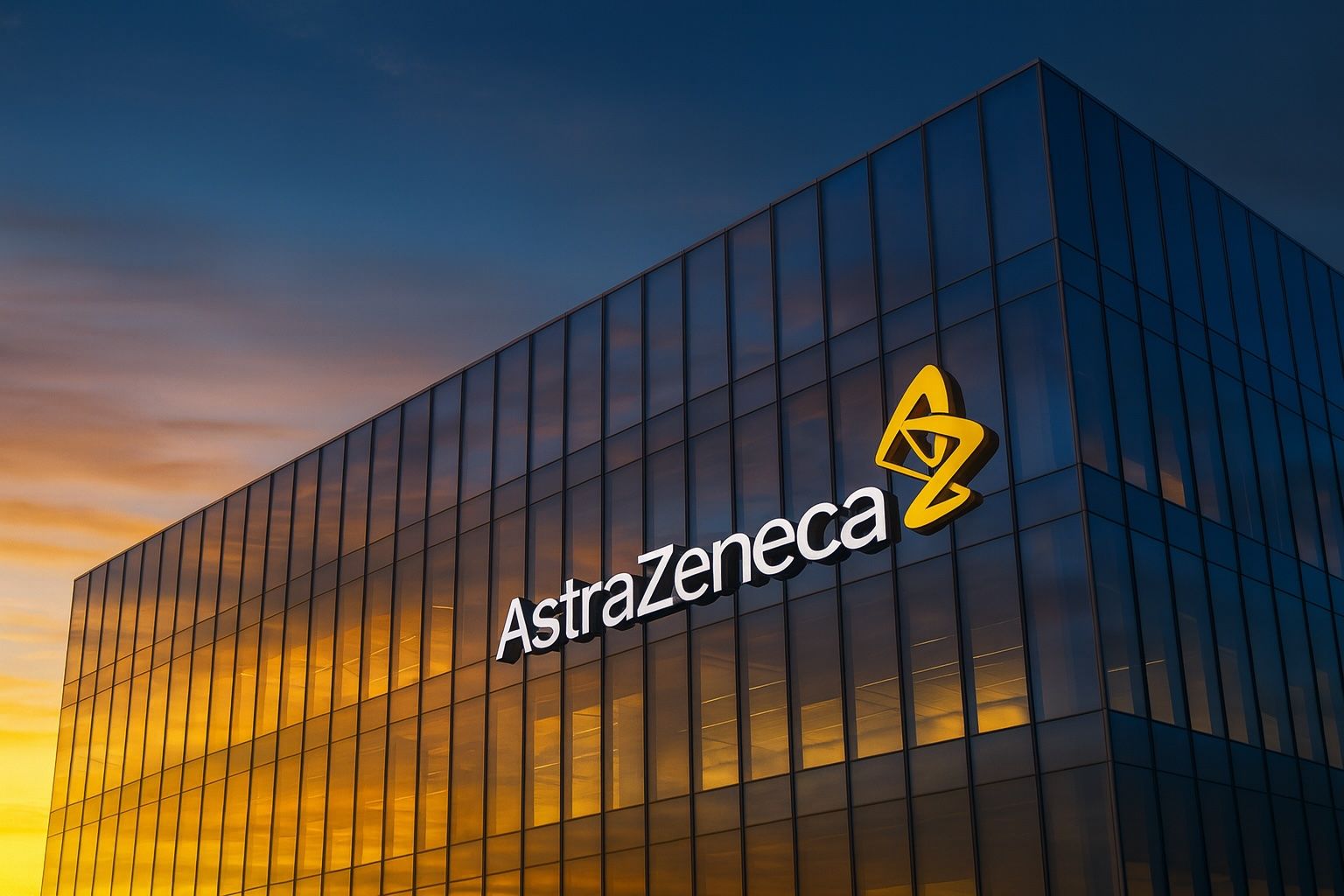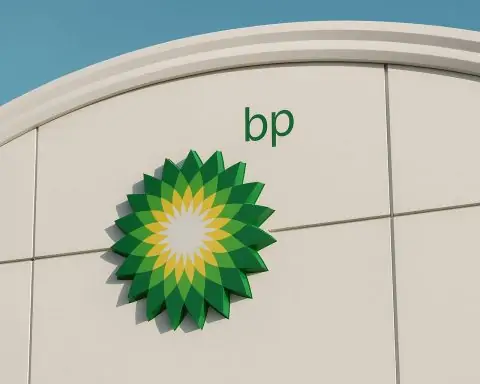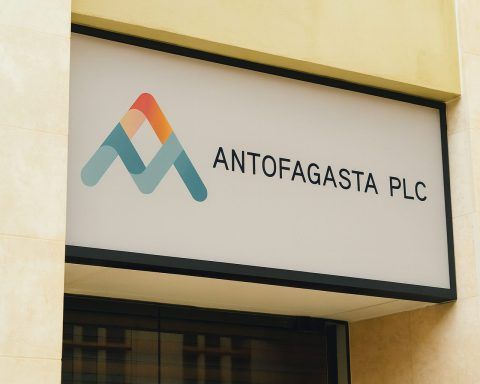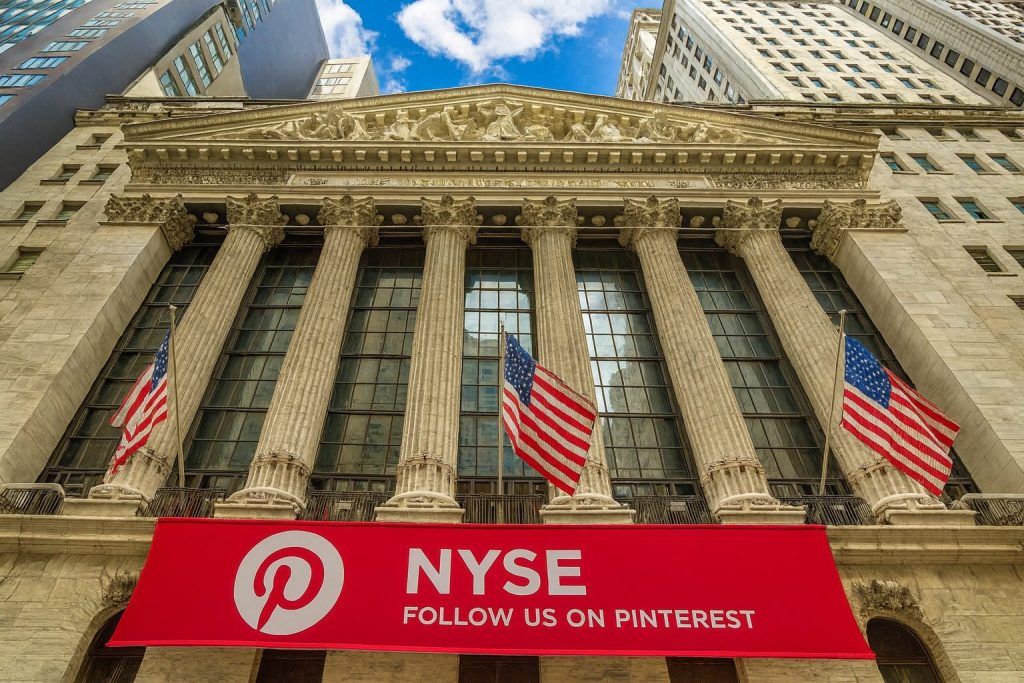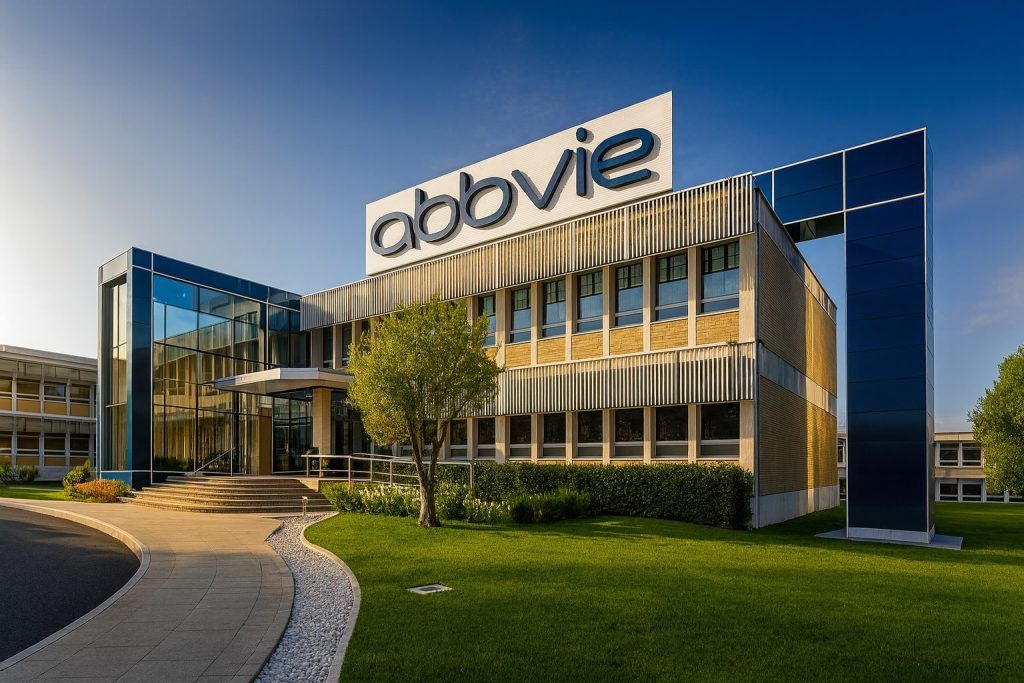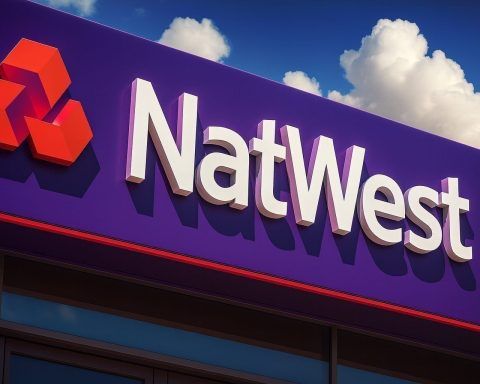- Ticker & Price: AstraZeneca PLC (AZN) – London/Nasdaq. As of Oct 10, 2025, the stock trades around GBX 12,782 (≈£127.82) or roughly $85 (ADR) [1] [2]. Market cap is about $264 billion, with a trailing P/E ~32 [3]. 1-year trading range is approximately $61–$86.6 (GBP 9,574–12,972) [4] [5].
- Operations: AZN is a global, science-led, patient-focused pharmaceutical company [6]. It was formed in 1999 by the merger of Sweden’s Astra AB and the UK’s Zeneca, and is headquartered in Cambridge (UK) and headquartered/libation London. 2024 revenues reached $54.1 billion (up 18% YoY) [7]. Core EPS was $8.21 [8], reflecting strong growth. Major marketed drugs include cancer therapies (Tagrisso, Imfinzi, Lynparza, Enhertu), cardiovascular/metabolic drugs (Forxiga/Xigduo, Brilinta, Lokelma), and respiratory/immunology drugs (Symbicort, Fasenra) [9]. 2030 goals include launching ≥20 new medicines and achieving $80B in sales [10].
- Financials & Valuation: Q2 2025 saw $14.46B sales (+16.1% YoY) and EPS $1.09 [11]. Profit margins are healthy (net margin ~14.7%, ROE ~32.8% [12]) and debt moderate (D/E ~0.55 [13]). The stock recently climbed above its 50-day ($78.97) and 200-day ($73.37) moving averages, near its 52-week high [14]. Beta is only ~0.36, implying relatively low volatility [15].
- Recent Catalysts: In late Sep 2025 AZN announced a harmonized U.S. listing – offering its ordinary shares on the NYSE alongside London/Stockholm listings [16] [17]. This came as its U.S. business is its largest (43% of revenue) and projected to reach 50% by 2030 [18]. Shortly after, CEO Pascal Soriot and Chair Michel Demaré emphasized the move would “reach a broader mix of global investors” while keeping the company headquartered in the UK [19] [20]. In early Oct, AstraZeneca broke ground on a $4.5 billion Virginia manufacturing plant (part of a $50B U.S. investment plan) [21] [22]. On Oct 10, AZN struck a drug-pricing agreement with the Trump Administration – committing to offer its medicines to U.S. Medicaid at “most favored nations” prices (lowest price globally) [23]. All these moves fueled a >10% share rally since late September [24].
- Analysts & Outlook: Street analysts rate AZN as a “Moderate Buy”, with 12-month targets in the high-$80s to $90s. For example, TipRanks shows an average target of ~$92.3 (≈$86 current price) [25]. Shore Capital (Oct. 8) even sees ~12% upside (target ~$179 vs ~$159 current, on a pre-split basis) [26]. Price targets range roughly $85–$97 [27], or £110–£145 in London market forecasts [28]. Forward EPS is expected around $4.51 for FY2025 [29], implying PEG ~2.0. In short, analysts see moderate upside but note AZN is already near historic highs.
Company Background
AstraZeneca PLC is a leading Anglo-Swedish pharmaceutical giant specializing in oncology, respiratory, cardiovascular/metabolic, and rare disease medicines [30] [31]. Headquartered in Cambridge, UK, it maintains primary listings on the London Stock Exchange and Nasdaq Stockholm, with secondary ADR trading in the U.S. [32]. The company was formed in 1999 by merging Sweden’s Astra AB and the UK’s Zeneca. Its 2024 revenues were $54.07 billion [33], driven by top-selling drugs like Tagrisso (lung cancer), Lynparza (ovarian cancer), Farxiga (diabetes), and Symbicort (asthma) [34]. In its 2024 Annual Report, AZN describes itself as “a global, science-led, patient-focused pharmaceutical business” and targets $80B in sales by 2030 with at least 20 new drugs launched [35] [36]. Current Chair Michel Demaré and CEO Sir Pascal Soriot (CEO since 2012) lead a company with roughly 70–80,000 employees worldwide, strategic R&D hubs in the US, UK, Sweden, China and emerging cell/gene therapy centers.
Recent News & Developments
U.S. Listing & Investments: On Sep 29, 2025, AstraZeneca announced it will directly list its ordinary shares on the New York Stock Exchange while retaining its London and Stockholm listings [37] [38]. Chair Demaré stated this “global listing structure” will let AZN tap “a broader mix of global investors” while remaining headquartered in Britain [39]. Analysts warn this shift could draw trading liquidity to New York, and other large UK firms (e.g. Wise, Unilever) may follow suit [40] [41]. Demaré noted U.S. shareholders are AZN’s largest investor group, and the U.S. business is nearly half of sales [42].
Virginia Plant: On Oct 9, Reuters reported AZN broke ground on a $4.5 billion antibody-drug conjugate plant in Albemarle County, VA [43]. This is part of AZN’s $50B U.S. expansion plan through 2030 [44] [45]. The plant (AZ’s largest ever facility) will create ~600 long-term jobs (3,000 construction) [46]. Soriot said the investment will “strengthen America’s national security” by securing the supply of important medicines [47]. AZN also announced plans to sell certain asthma/diabetes drugs directly to U.S. patients at steep discounts (up to 70%) [48], aligning with the Trump Administration’s interest in lower drug prices.
Drug Pricing Deal: On Oct 10, President Trump announced a deal with AstraZeneca whereby the company “will offer all of their prescription medications to [U.S.] Medicaid at most favored nations prices – the lowest price anywhere in the world” [49]. This mirrors a similar agreement Pfizer made in late Sept. Trump said pharmaceutical tariffs will be re-imposed in 2025 unless such deals are struck [50]. The pricing deal is expected to benefit U.S. patients and give AZN tariff relief (up to 3 years), while capping Medicare/Medicaid costs. Investors cheered the news, boosting AZN shares (in tandem with Pfizer, Merck) as political risk on drug margins eased.
Analyst Commentary: In this backdrop, analysts see AZN as a likely follow-up to Pfizer’s deal. JPMorgan analyst Lucy Coutts told Reuters that “AstraZeneca could be next” in White House partnerships, especially given its U.S.-leaning revenues and recent U.S. investments [51]. Market commentators (e.g. The Motley Fool) note that Pfizer’s $70B U.S. pledge set a template, and AZN’s similar $50B plan and NYSE listing make it a strong candidate for future deals [52] [53]. In summary, the beat-the-tariff strategy (plant, listing, pricing deals) is a major strategic theme.
Other News: Earlier in September, AZN had come under pressure after Handelsbanken cut its rating citing a pulled-back £200M R&D investment in Cambridge [54]. This caused a brief 3–4% dip on Sep 15 [55]. That pause was later reported as reversed following the Trump deal talks. Aside from these, AZN’s recent quarterly report (July 29) showed beat on EPS ($1.09 vs $1.06 est.) and strong 16% revenue growth [56], reinforcing confidence. Overall, the latest developments center on U.S. expansion, pricing policy, and strong uptake of AZN’s blockbuster drugs.
Financial Performance & Stock Chart
AstraZeneca’s financials have been robust. In H1 2025, revenue grew double-digits across divisions. Notably, Q2’25 sales were $14.46B (up 16.1% YoY) with EPS $1.09 (exceeding expectations) [57]. For full-year 2024, total revenue was $54.07B [58] and core EPS $8.21 [59] (up 13% YoY). Profitability remains strong (net margin ~14.7% and ROE ~32.8% in Q2 [60]). Analysts forecast FY2025 EPS of $4.51 (reflecting continued growth) [61].
Balance-sheet metrics are solid: debt/equity ~0.55 and current ratio ~0.86 [62]. The dividend is paid semiannually (last paid $0.505 per ADR on Sept 8, 2025 [63]), implying roughly a 2% yield (payout ~38%). Management has reiterated a progressive dividend policy.
The stock chart has been very bullish. After trading as low as ~$61 in early 2025, AZN shares jumped sharply on Sept 30 (from GBX 11,182 to 12,436) when the NYSE-listing plan was announced [64]. In early Oct, the stock hit a 52-week high (around GBX 12,972 on Oct 1) [65]. Despite a mild pullback, the price remains near all-time highs (trading ~1-2% below the peak, ~GBX 12,800). Technically, AZN has broken above its 50-day moving average (~$79) and is comfortably above its 200-day (~$73) [66] – a bullish signal. Momentum indicators (notably on higher-than-average volume) suggest sustained interest. In sum, the stock’s chart shows a clear uptrend since mid-2024, and the recent breakout has led analysts to reconsider valuation levels.
Expert Quotes & Opinions
- Lucy Coutts (Investec): “AstraZeneca could be next [in striking a deal] after it broke ground on a $4.5B plant in Virginia this week and is planning a U.S. listing of its shares” [67]. She notes AZ’s U.S.-skewed revenues make it a prime candidate for Washington’s favor.
- Pascal Soriot (CEO): On the VA plant ground-breaking, Soriot said the investment will “strengthen America’s national security and health sovereignty” by boosting domestic drug supply [68]. He and Chair Demaré have publicly emphasized AZN’s commitment to the U.S. market and customers (in addition to global commitments).
- Michel Demaré (Chair): In the NYSE listing announcement, Demaré explained the move “will allow us to reach a broader mix of global investors” while keeping AZ headquartered in the UK [69]. This underscores management’s view that New York offers deeper capital markets without abandoning London.
- Market Commentators: The Motley Fool opined that at a forward P/E of only ~15, AZN “should be able to deliver solid gains for long-term investors” [70], especially given its pipeline of dozens of positive trial readouts. Other analysts (e.g. Shore Capital) have explicitly named AZN as a likely beneficiary of the new White House pharma strategy [71]. Conversely, some hedge funds remain cautious: recent analyst updates (e.g. Handelsbanken) noted AZN’s ambitious $80B-by-2030 revenue goal might be optimistic [72].
Pipeline & Innovation Updates
AstraZeneca’s R&D pipeline is deep, especially in oncology and immunology. Key late-stage programs include: antibody-drug conjugates (e.g. Enhertu for breast cancer, co-developed with Daiichi Sankyo), IL-5 inhibitors, and new ARNI heart failure drugs. Notably, AZN has filed FDA approval for belantamab mafodotin (Blenrep) combinations in multiple myeloma; an advisory decision is due Oct 23, 2025 [73]. Success there would expand AZ’s myeloma franchise. In addition, AZ is investigating next-gen diabetes/obesity drugs (leveraging forxiga and others) and continues vaccine/rare disease research.
In innovation and partnerships, AZN is pushing cutting-edge tech: it agreed in Oct 2025 to a $555M AI/CRISPR collaboration with Algen Biotechnologies, giving it rights to a new AI-guided gene-editing platform for immune therapies [74]. Earlier in 2025, AZN acquired Belgian biotech EsoBiotec for up to $1B to boost its in vivo CAR-T capabilities [75]. In biotech discovery, AZ teamed with Turbine AI (using AI to design antibody-drug conjugates) in a no-money-down R&D alliance [76] [77]. These deals highlight AZN’s focus on emerging modalities (AI, cell/gene therapy). Overall, analysts note AZN’s pipeline productivity has accelerated, with ~24 pipeline advances in 2024 and dozens of late-stage readouts, giving confidence in future growth [78] [79].
Legal, Regulatory & Strategic Developments
U.S. Policy: The Trump Administration’s aggressive pharmaceutical agenda has profoundly affected AZN. After Pfizer’s pact, AZN quickly engaged on pricing: as noted, it will supply Medicaid at the lowest international prices [80]. Meanwhile, discussions with HHS have reportedly included incentives like lifting tariffs (AZN announced that most drug tariffs would be waived for 3 years in return) – a major financial benefit. Separately, AZN must prepare for expanded Medicare price negotiations starting 2026 (part of Biden’s IRA), which could cap prices on some of its top drugs.
UK/Europe: AstraZeneca reaffirmed its UK roots amid the NYSE plan: the company remains UK tax-resident and will stay listed in London [81] [82]. UK officials publicly welcomed the commitment, saying it “signals clear confidence in the UK economy” [83]. On the flip side, politicians have criticized AZN’s pause of its £200M Cambridge investment (related to COVID vaccine facility) [84], though that decision was reversed following U.S. talks. EU regulators are also watching AZN, especially for competition in areas like biosimilars and GDPR data compliance, but no major EU-specific actions have been announced.
Litigation/Regulatory: No new major litigation has hit AstraZeneca this week. Its high-profile legal battles (e.g. vaccine indemnity, IP suits) remain in the background and unconnected to stock moves. Environmental/regulatory compliance (ESG reporting) continues per London and Swedish standards, with no recent fines.
Market & Competitor Analysis
AstraZeneca sits among the world’s largest drugmakers. Its closest peers in market cap are Roche (~$350B), Johnson & Johnson (~$400B), Pfizer (~$300B), and Novartis (~$300B). Unlike its peers, AZN has minimal exposure to blockbuster weight-loss drugs (Novo Nordisk/Lilly dominate GLP-1 obesity market), which could be a near-term competitive gap. However, AZ’s strength in oncology (Imfinzi vs. Merck’s Keytruda, Enhance vs. Lilly’s Zollic, etc.) and cardiometabolic treatments (Farxiga in diabetes/CKD) keep it competitive. Its respiratory franchise (Symbicort, Fasenra) competes with Novartis and GSK.
On markets, AstraZeneca’s stock is outperforming the FTSE 100 in 2025 thanks to these news, although the FTSE (up ~7% YTD) still lags the S&P500 (up ~15% YTD) [85]. Analysts note a “valuation gap” – UK stocks (FTSE) have trailed U.S. indexes for years [86] – and AZN’s NYSE listing may help narrow that. Charles Hall of Peel Hunt observes that a large proportion (~22%) of FTSE companies’ shareholders are US-based, so moves like AZN’s are strategic [87].
Industry Trends: The broader pharma sector is in flux. Drugmakers are under pressure to cut costs (through drug pricing deals) but are also reallocating capital to R&D and manufacturing in the U.S. Big Pharma rival Eli Lilly is investing $50B in U.S. facilities (including a $5B insulin plant) [88]; Roche is building in Texas; GSK has seen its stock jump after management changes (Walmsley’s exit) [89]. The Trump/Pfizer/AZN pricing initiative has shifted industry strategy toward “America-first” manufacturing and pricing compliance.
Analyst Ratings & Investment Forecasts
Wall Street consensus is cautiously bullish. Most brokerages rate AZN a Buy or Overweight, averaging a 12- to 18-month price target in the high-$80s/low-$90s. For example, TipRanks shows 3 top analysts giving an average target of $92.33 (8.6% above the $85 level) [90]. Price targets range roughly $85–$97 [91]. Shore Capital’s research (Oct 8) implies about a 12% upside to ~$179 (on ADR basis) [92]. UK analysts forecast similarly moderate upside (average target ~£134 vs £127 current [93]). The consensus rating on MarketBeat is “Moderate Buy” [94].
Analysts cite AZ’s strong pipeline and U.S. expansion as positives, but flag risks: pipeline readouts always carry binary risk, and policy/tariff shifts could erode margins. Simply Wall St (Oct 3) noted analysts raised the 2030 sales forecast to $79B (from $75B) based on pipeline progress, and bumped the fair value slightly higher [95] (fair value now ~£138). However, concerns remain around execution of new manufacturing sites and the effect of Medicare negotiations (starting 2026) on profits [96].
Valuation: At current prices, AZN trades at ~P/E 32 (trailing) but only ~15 forward (2026E earnings) [97]. Its forward PEG (~2.0) is moderate for pharma. The company’s long-term target (Ambition 2030) implies revenue roughly doubling from 2024 to 2030, which is aggressive and underpins some analysts’ skepticism [98].
Dividends, M&A & Strategic Moves
- Dividends: AstraZeneca pays a semiannual dividend. The last payout was $0.505 per ADR (paid Sep 8, 2025) [99], implying ~$1.01 annualized (≈2% yield on current stock). The dividend payout ratio is modest (~38%), allowing room for increases. Management has signaled the dividend will grow in line with earnings, unless major acquisitions arise.
- M&A/Alliances: AZN is not currently pursuing any mega-mergers. Instead, it is licensing and acqui-hiring innovative biotech: the Algen and EsoBiotec deals in 2025 (total ~$1.5B up-front) bolstered its gene-editing and cell therapy pipeline [100] [101]. These align with AZ’s strategy of “bolt-on” deals rather than billion-dollar takeovers. AZN continues collaborations (e.g. Daiichi on Enhertu, J&J on Stellara, Daiichi on antibody programs) rather than in-house development only.
- Restructuring/Capital Allocation: The major corporate restructuring news was the announcement of a harmonized global listing structure [102]. There has been no change to AZN’s headquarters or London listing. On the manufacturing side, the $50B U.S. project will require substantial capex through 2030, but AZN is funding this from existing cash flow and modest debt. Management has maintained its “investment grade” credit rating. There are no layoffs or plant closures announced.
- Spin-offs or Divestitures: None. AZN remains integrated; it has not announced any major sale or spin-off of units. It did divest some non-core consumer products earlier in the decade, but its current focus is on expanding rather than trimming the core pipeline.
Outlook & Stock Forecast
Looking forward, most experts see AstraZeneca as a steady grower with potential upside from U.S. expansion and new drugs, but not a sky-high momentum stock. Analysts’ price targets in the mid-$90s (~£130–£140) imply ~10-15% upside from current levels [103] [104]. Some bullish cases argue AZN’s ambitious R&D and investment program could drive growth well beyond consensus: if many pipeline projects succeed (20+ new launches by 2030) and U.S. sales hit $40–45B by 2030, then revenues could reach $80B as planned [105]. In such a scenario, long-term fair value could be near the upper end of targets.
On the technical side, the chart breakout suggests momentum. Traders note that AZN has cleared key resistance near $78–80 and is consolidating at new highs. Positive volume on the recent run indicates institutional interest. Some chart analysts cite a possible near-term target around $95 (echoing consensus price targets) if the uptrend continues. A pullback to the 50-day MA (~$79) could be viewed as a buying opportunity in the short term.
Risks: Any disappointments (e.g. a failed drug trial, or tougher-than-expected U.S. pricing rules) could cap gains. Margin pressure from Medicare/Medicaid price controls or renewed tariffs (if the government’s commitments change) could weigh on earnings. Brexit-related currency swings and regulatory changes in the UK/EU are minor risks but less immediate than U.S. policy.
Expert Forecast: In sum, strategic analysts predict moderate growth. TipRanks’s consensus sees AZN around $92 in a year [106]. Shore Capital (contrarian) implies up to ~$180 by late 2026 (based on current ADR pricing) [107]. The Motley Fool suggests that at today’s valuations, “solid gains” are probable over the long term [108]. In our view, AstraZeneca’s stock could reach the low-$90s by late 2025/early 2026 if the U.S. expansion proceeds as planned and there are no major pipeline setbacks. Its fundamentals and strategic moves are strong, so analysts generally rate it a hold-to-buy with a 12–18 month horizon. Investors should watch upcoming catalysts (e.g. the Oct 23 belantamab decision, next earnings update) and any policy shifts.
Sources: Authoritative financial news, press releases and analyst reports were used, including Reuters, Morningstar/MarketBeat, ts2.tech, AstraZeneca filings, and industry media [109] [110] [111] [112] [113] [114] [115]. These reveal the latest data on AZN’s price, performance, news, and expert commentary.
References
1. www.investing.com, 2. www.marketbeat.com, 3. www.marketbeat.com, 4. www.marketbeat.com, 5. www.marketbeat.com, 6. www.astrazeneca.com, 7. www.astrazeneca.com, 8. www.astrazeneca.com, 9. www.marketbeat.com, 10. www.astrazeneca.com, 11. www.marketbeat.com, 12. www.marketbeat.com, 13. www.marketbeat.com, 14. www.marketbeat.com, 15. www.marketbeat.com, 16. ts2.tech, 17. www.astrazeneca.com, 18. www.reuters.com, 19. www.astrazeneca.com, 20. www.reuters.com, 21. www.reuters.com, 22. ts2.tech, 23. www.reuters.com, 24. www.nasdaq.com, 25. www.tipranks.com, 26. www.nasdaq.com, 27. www.tipranks.com, 28. www.marketbeat.com, 29. www.marketbeat.com, 30. www.marketbeat.com, 31. www.astrazeneca.com, 32. www.astrazeneca.com, 33. www.astrazeneca.com, 34. www.marketbeat.com, 35. www.astrazeneca.com, 36. www.astrazeneca.com, 37. ts2.tech, 38. www.astrazeneca.com, 39. www.astrazeneca.com, 40. www.reuters.com, 41. www.reuters.com, 42. www.reuters.com, 43. www.reuters.com, 44. ts2.tech, 45. www.reuters.com, 46. www.reuters.com, 47. www.reuters.com, 48. www.reuters.com, 49. www.reuters.com, 50. www.reuters.com, 51. www.reuters.com, 52. www.reuters.com, 53. www.nasdaq.com, 54. www.reuters.com, 55. www.reuters.com, 56. www.marketbeat.com, 57. www.marketbeat.com, 58. www.astrazeneca.com, 59. www.astrazeneca.com, 60. www.marketbeat.com, 61. www.marketbeat.com, 62. www.marketbeat.com, 63. www.marketbeat.com, 64. www.investing.com, 65. www.investing.com, 66. www.marketbeat.com, 67. www.reuters.com, 68. www.reuters.com, 69. www.astrazeneca.com, 70. www.nasdaq.com, 71. www.reuters.com, 72. www.reuters.com, 73. www.onclive.com, 74. www.reuters.com, 75. www.reuters.com, 76. www.fiercebiotech.com, 77. www.fiercebiotech.com, 78. www.nasdaq.com, 79. www.astrazeneca.com, 80. www.reuters.com, 81. www.astrazeneca.com, 82. www.reuters.com, 83. www.reuters.com, 84. www.reuters.com, 85. www.reuters.com, 86. www.reuters.com, 87. www.reuters.com, 88. ts2.tech, 89. ts2.tech, 90. www.tipranks.com, 91. www.tipranks.com, 92. www.nasdaq.com, 93. www.marketbeat.com, 94. www.marketbeat.com, 95. simplywall.st, 96. simplywall.st, 97. www.nasdaq.com, 98. www.reuters.com, 99. www.marketbeat.com, 100. www.reuters.com, 101. www.reuters.com, 102. www.astrazeneca.com, 103. www.tipranks.com, 104. www.nasdaq.com, 105. www.astrazeneca.com, 106. www.tipranks.com, 107. www.nasdaq.com, 108. www.nasdaq.com, 109. www.reuters.com, 110. www.reuters.com, 111. www.reuters.com, 112. www.nasdaq.com, 113. www.astrazeneca.com, 114. www.tipranks.com, 115. www.astrazeneca.com
